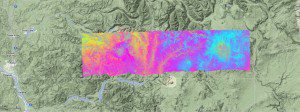
A UAVSAR interferogram shows active volcano Mount St. Helens (left) and dormant volcano Mount Adams, both in Washington state. The sensor collected data for this image during flights in July 2009 and August 2010 to compute the surface deformation that could indicate activity in the volcanoes' magma. No deformation was evident during this period.
A NASA aircraft carrying a unique 3-D aerial radar sensor left California onOct. 2, 2012, for a 10-day campaign to study active volcanoes in Alaska and Japan.
The 3-D radar sensor was developed by NASA’s Jet Propulsion Laboratory (JPL), Pasadena, Calif. The modified NASA C-20A (G-III) aircraft, with JPL’s Uninhabited Aerial Vehicle Synthetic Aperture Radar (UAVSAR) installed in a pod under its belly, departed NASA’s Dryden Aircraft Operations Facility in Palmdale, Calif., Oct. 2, en route to Joint Base Lewis-McChord in Tacoma, Wash. Along the way, it will image volcanoes in the western United States.
After refueling, the aircraft will travel on to Joint Base Elmendorf-Richardson near Anchorage, Alaska, where UAVSAR will image a series of volcanoes, including those in the Aleutian Islands. UAVSAR can see below Earth’s surface to monitor subtle deformations. NASA scientists periodically use UAVSAR to monitor subtle changes in volcanic activity. The radar uses a technique called interferometry, which sends pulses of microwave energy from the sensor on the aircraft to the ground to detect and measure subtle Earth surface deformations.
The plane then will fly to Japan’s Yokota Air Force Base near Tokyo. Yokota is the staging location for science missions to collect data about volcanoes on several islands in Japan that pose a hazard to nearby populations. On its return, the aircraft will repeat the route, acquiring data from the opposite viewing direction, before arriving back at its base in Palmdale on Oct. 11.
Image courtesy of NASA.

